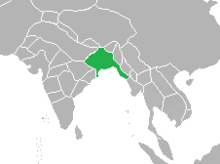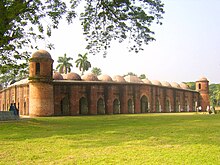Sultanate of Bengal
The Sultanate of Bengal, which was under Islamic rule, was an independent state from the Sultanate of Delhi , which included all of Bengal and parts of what is now Myanmar . It existed from 1352 to 1576 with an interruption by the Pashtun Sher Shah Suri in the years 1539 to 1554; afterwards it was annexed by the Mughal Empire and administered by governors ( subahdars ). Capital cities were Gaur , Pandua and Sonargaon .
history
In the 14th century several provinces of the Sultanate of Delhi detached from this; in Bengal the city-states Lakhnauti (later Gaur), Satgaon and Sonargaon emerged . Shamsuddin Ilyas Shah achieved their unification by military means and founded the independent Sultanate of Bengal in 1352; a year later he was victorious against the troops of the Delhi sultan Firuz Shah Tughluq . In the following years he led several campaigns against Bihar and Orissa , which recognized the sovereignty of the Sultan of Bengal. At the beginning of the 15th century, the Kingdom of Arakan was added in northwest Burma. After the conquest by Sher Shah Suri, only a faint reflection remained of the once strong empire; It was conquered in 1576 by the armies of the Mughal ruler Akbar I and annexed to the Mughal Empire as a province, against which, however, an ultimately unsuccessful uprising developed in the following years (see Kherua Mosque ).
In its heyday, the Sultanate of Bengal maintained diplomatic relations with the Ming Dynasty Empire in China and the Egyptian Mameluks . Later the Doge of Venice and the King of England also sent ambassadors to the court of the "Kings of the East". Ultimately, however, it was - in addition to internal conflicts - the increasing colonial activities of the European powers Portugal and England that dealt the fatal blow to the Sultanate of Bengal, but ultimately also to the Mughal empire.
economy
The fertile alluvial land of Bengal forms the economic basis for the development of a state of its own, in which all kinds of materials were produced and traded. It was considered by the Europeans to be the richest country to trade with. There was a separate coinage, but this was not always handled in the same way in the different minting locations.
Culture
Persian influences remained in literature and painting; In the architecture, with the inclusion of regional building traditions, a unique Bengali style developed , the forms of which spread from the Mughal court to the palaces and merchant houses ( havelis ) of the Rajputs in northwest India. Sultan Sikandar I , the son of Ilyas Shah, built the Adina Mosque, the largest mosque on the Indian subcontinent, in Pandua in 1373 . The mosque town of Bagerhat was established in the 15th century and has been recognized by UNESCO as a World Heritage Site since 1985 .
See also
literature
- Richard M. Eaton: The Rise of Islam and the Bengal Frontier, 1204-1760 (= Comparative Studies on Muslim Societies. 17). University of California Press, Berkeley CA et al. 1996, ISBN 0-520-20507-3 .
- Syed Ejaz Hussain: The Bengal Sultanate. Politics, Economy and Coins. (AD 1205-1576). Manohar, Delhi 2003, ISBN 81-7304-482-1 .

